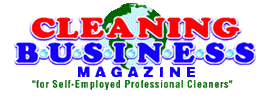Bidding and Estimating Column
When I was in Portland OR last month to attend the Cleanmed Show, I noticed that there was a solar energy conference at the same convention center. Being I have an interest in solar energy, I wandered over to see what I could learn. To my surprise there was a presentation on bidding and estimating, so I got a press pass and sat through the presentation. Even though it was targeted to solar energy construction contractors, much of the information and concepts presented apply to cleaning contractors. Here’s an overview of my notes from the presentation by Leslie Shiner, who has a book titled “Turning a Profit as a Contractor”. You can order Leslie’s book at www.moneymazebooks.com Or contact her via email: L_Shiner@ShinerGroup.com Ph: 415-383-6255
Figuring the cost of labor utilization:
- Providing micselleous tools for an worker costs about .50 cents an hour
- Providing a vehicle for a worker costs $3.00 to $5.00 per hr.
- Providing Health Insurance coverage for a worker costs about $420.00 mo, for a 40 hr wk, or about $2.50 per hr., if an employee wk less hours per wk, the hourly cost of coverage goes up.
- The total billable rate for an employee is often or should be 2 to 3 times the hourly rate the employee is actually paid per hour. A fully burdened billable hourly rate is often 55% to 65% more than the hour rate the employee is paid.
- One time service calls are expensive to perform. Billable rates for this category of service need to be higher than regularly serviced customers in order to cover your actual costs. A safer approach is to sell customers on a service agreement package, this way you can keep your staff busy and provide ongoing maintenance that helps prevent emergency and unscheduled service calls which are more costly to provide.
- Other billing options include: flat fee rate and minimum charge,
There is no such thing as a 6 hr. task or job, a 5 or 6 hour assignment is going to eat up an entire 8 hr. day regardless of what you are able to bill the customer for…
For the average full time (40 hr. per wk employee) there are 2080 workable hours in a year. Keep in mind that not all of those hours are productive or billable hours. No one is fully productive the entire time they are on the clock.
One of the questions a manager and or supervisor needs to constantly ask themselves, is: Are your most expensive employees being assigned to complete the most difficult, challenging or skilled tasks that you are able bill the highest rate for you’re customers? If not, why not?
An example would be, instead of having a technician or two technicians stock the service truck or clean up the work space or run for supplies or parts, could you a less skilled and priced technician pull parts and stock the trucks, prior to start time for the higher skilled technician. Would it be less expensive to use a taxi or Uber to pick up and deliver needed supplies to job sites or the warehouse rather than having a skilled worker, who could be doing billable work, picking up and delivering supplies or equipment that could be done by a less skilled and costly worker.
When workers run into a problem and can’t complete an assigned task, is there a backup plan in place so some aspect of the work can continue vs bringing the project to a standstill or stopping point.
There is Five Area of Significance in Managing for Profit
- Estimating and Sales
- Project Management
- Financial Management
- Analysis
- Strategic Management for Profit
The Profit Cycle Includes
- Estimating and Sales
- Production
- Accounting
- Analysis
You need to Know How to Create a Proposal as a Repeatable Process
- Use software
- Distinguish between Budget and Proposal
- Proposal is for the client
- Budget is basis of Job Cost Management
- Measure Productivity
- Understand your overhead
- Know the difference between Mark up and Margin
Overhead and direct labor costs are not negotiable, they must be fully covered in your bid/price or you will lose money
Profit can be negotiable
Marketing Basics
- Ask for Referrals and ask again
- The #1 source of new business, is referrals and repeat business
- Have an online presence
- Utilize social media
















